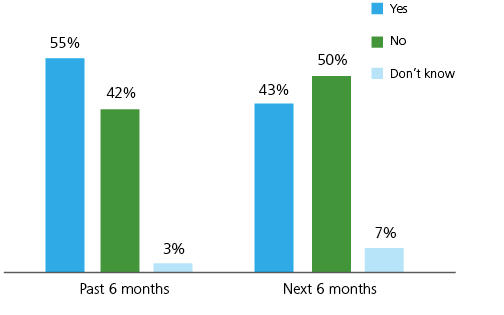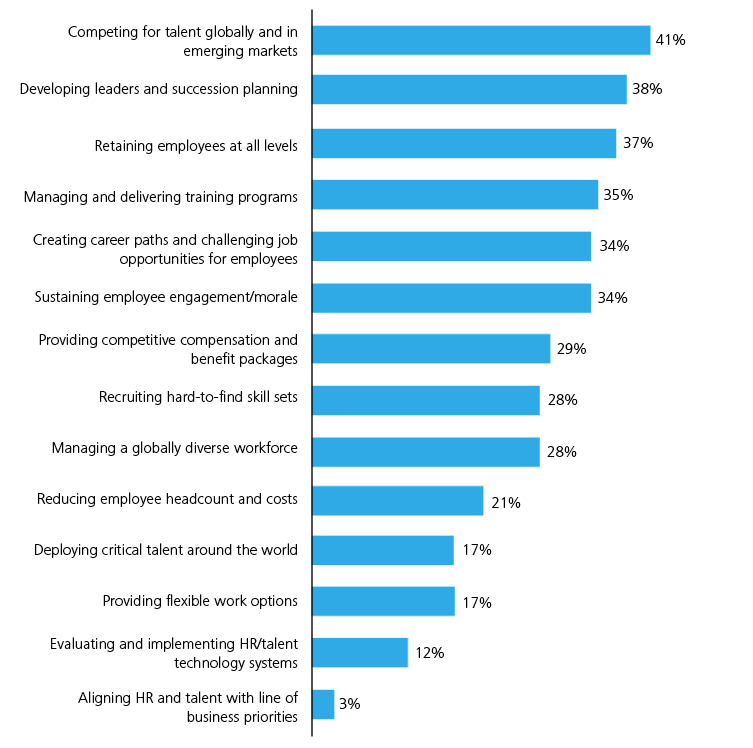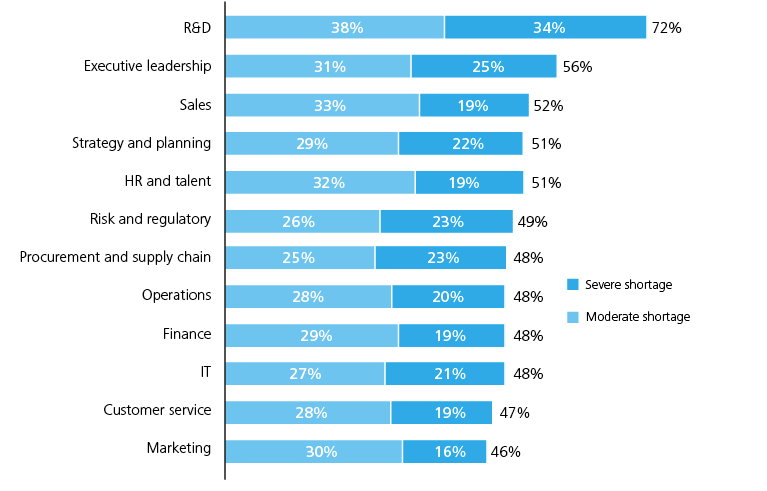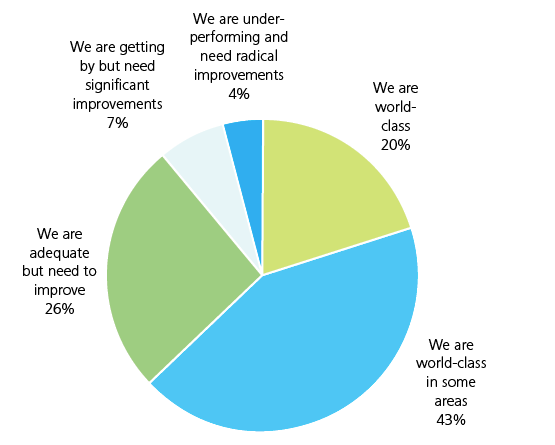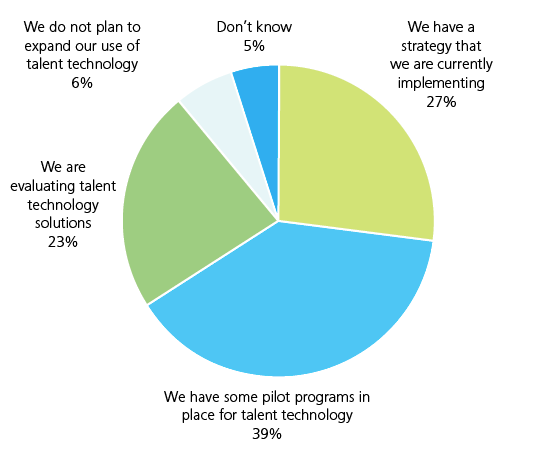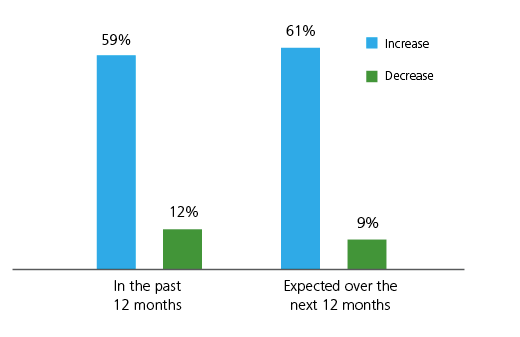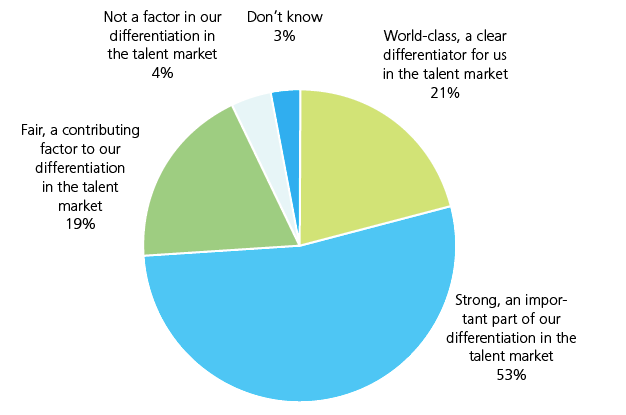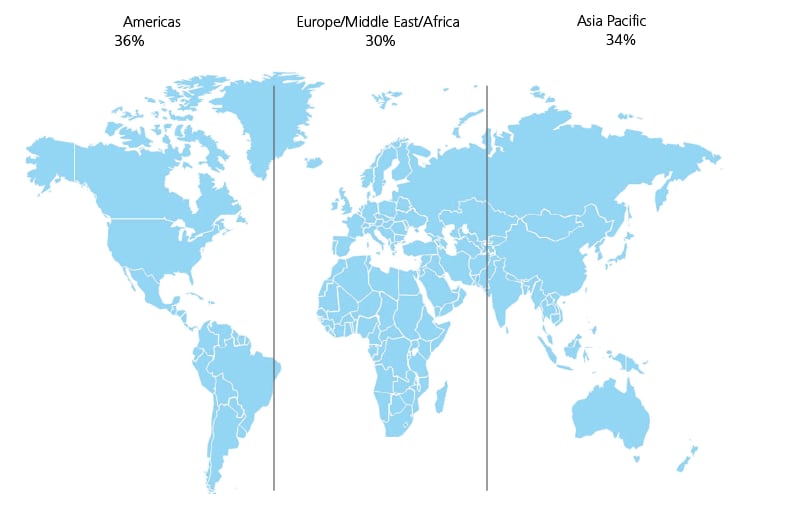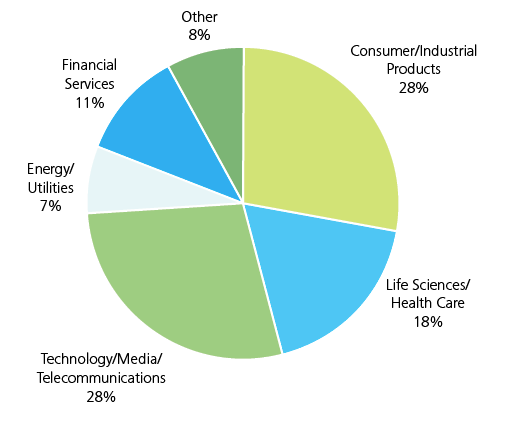Talent Edge 2020: Blueprints for the New Normal has been saved

Talent Edge 2020: Blueprints for the New Normal
02 December 2010
"Talent Edge 2020: Blueprints for a New Normal" is the first installment of a post-recession longitudinal study that explores the changing talent priorities and strategies of global and large national companies. This inaugural edition features results from an October 2010 survey of 334 senior business leaders and human resource executives worldwide.
Key findings
As companies worldwide struggle to move beyond the great recession of 2009, many business leaders are adjusting their talent strategies to meet the shifting demands characterized as the “new normal.” While the inclination may be strong to revert to strategies that served them well prior to the economic crisis, many executives seem to recognize that the forces shaping future talent needs, such as globalization and an aging workforce, continued to accelerate during the downturn and that they now require new talent strategies to position their companies for success.
To bring these issues into clearer focus, Deloitte launched Talent Edge 2020—our second longitudinal survey series, following in the path of Deloitte’s 2009-2010 survey series, Managing Talent in a Turbulent Economy. Talent Edge 2020 aims at exploring talent strategies, concerns of global companies, and unfolding employee trends as companies confront a fresh set of challenges that we expect will influence the next decade and beyond.
Nearly three in four executives surveyed predict talent shortages in R&D.
In October 2010, Forbes Insights, on behalf of Deloitte, conducted a survey of 334 senior executives and talent managers at large companies worldwide, across a range of major industries. Below are the key findings:
The talent paradox is already creating key shortages.
High unemployment rates in the U.S. and abroad have not created the talent surplus many would have predicted. On the contrary, many executives predict talent shortages across key business units, such as research and development (R&D) and executive leadership, which are needed to drive innovation and growth.
Nearly three in four executives surveyed predict talent shortages in R&D. Companies are increasingly challenged to develop the next generation of leaders: looking at the more complex and challenging global business environment and the pending retirement of Baby Boomers and senior leaders, many executives expressed concern over their companies’ leadership development programs and pipelines.
Executives who participated in this survey believe “developing leaders and succession planning” is the current top concern and talent priority. They also believe this will be the number one talent priority three years from now.
The race for talent is global.
The recession did not reduce the pace of globalization—instead, many executives recognize that the once-emerging markets of the pre-recession days have become the catalyst for future growth, placing tremendous demands on talent managers to get new people in new jobs at new locations.
- More than four in ten executives surveyed (41%) rated competing for talent globally as one of their most pressing talent concerns—the highest of any answer in the category.
Companies with a retention plan in place reported they will ramp up financial and non-financial incentives in the year ahead.
“World-class” talent leaders are pursuing a different agenda.
Executives who describe their companies’ talent programs as “world-class” appear to have a different set of priorities and a stronger focus on long-term talent investments than their colleagues who consider their companies to be adequate or needing improvement in talent programs.
- Companies self-described as “world-class” have a clear sense of the pressing talent issues three years from now and are more likely to make investments in creating career paths and challenging opportunities for employees (46% for “world-class” firms vs. 36% for all others), developing leaders and succession planning (48% vs. 36%), and recruiting hard-to-find skill sets (42% vs. 29%).
Companies with retention plans in place are moving beyond anxiety, and are taking action.
Most executives surveyed (63%) are either highly or very highly concerned about employee retention over the next 12 months. Companies with a retention plan already in place are moving beyond anxiety and focusing on different retention initiatives.
- Companies with a retention plan reported they will ramp up financial and non-financial incentives in the year ahead: 69% will “significantly increase” or “increase” their focus on compensation vs. 48% of those without a retention plan; 76% of those with a retention plan will expand benefits vs. 55% without a plan; and 70% with a plan in place will boost non-financial incentives vs. 52% of those without a plan.
The great recession leads to the “great rebalancing”
As the great recession gives way to uneven economic growth, executives worldwide are rebalancing their corporate strategies. Specifically, according to Deloitte’s analysis of the survey data, corporate leaders are struggling to find the appropriate equilibrium between austerity measures designed to meet the new economic realities and the need to invest for future expansion (at the same time rebalancing their geographic portfolios).
When asked to list the top strategic issues their companies are facing, executives who participated in the survey ranked improving top- and bottom-line performance highest at 32%, followed closely by cutting and managing costs at 31% (see figure 1). However, as Figure 1 shows, a strong 29% of survey participants listed developing new products and services as a top strategic priority, while 28% reported their companies are focused on expanding into global and new markets and 27% named investing in innovation/R&D.
Investing in the next generation of corporate leaders also ranks high on the management agenda today. Among our survey participants, more than a quarter (27%) ranked “acquiring and developing leaders and talent” as a key strategic priority (see figure 1).
Figure 1. Which strategic issues currently capture the most management attention at your organization?
By the end of the previous longitudinal survey series, acquiring customers and cutting costs had emerged as the most important strategic issues among executives who participated. Today, no single issue dominates the corporate agenda. In 2009, while a majority of executives surveyed cited acquiring customers (50%) and cutting costs (57%) as a top priority, today those figures have dropped to 29% and 31%, respectively. At the same time, expanding into new and global markets increased significantly from 14% to 28%, as did investing in innovation (from 11% to 27%) and leveraging technology (from 10% to 20%)(see figure 1).
Current survey data suggests that the impact of the recession still permeates corporate strategies and talent priorities, with many companies keeping an eye on costs as a means to maximize profitability. At the same time, smart investments are being made. While executives and talent managers participating in this survey are still working to right-size their workforces, many are looking beyond headcount reductions and exploring new ways to achieve their business growth goals.
Supporting the finding that the recession is still impacting corporate talent strategies, over the past six months, more than half the executives surveyed (55%) reported their companies had experienced layoffs (see figure 2)—roughly in line with the layoff figures from a year ago in the September 2009 and December 2009 surveys. Looking ahead, however, this figure falls, as 43% expect layoffs over the next six months. And when executives were asked to list the most pressing talent concerns at their companies, reducing headcount was ranked ten out of fourteen.
Digging deeper: Consumer/Industrial Products, Financial Services, and Technology/Media/Telecom companies appear to be experiencing more layoffs than other industries. Nearly two-thirds (63%) of Consumer/Industrial Products executives surveyed reported layoffs in the past six months, as did 61% of Financial Services and 57% of Technology/Media/Telecom respondents. Just less than half (49%) of Life Sciences/Health Care and 29% of Energy/Utilities respondents reported layoffs over the same period. The outlook for the future is generally optimistic. A significantly lower percentage of executives expect layoffs in the next six months across all industries except Energy/Utilities, which remains the same.
Figure 2. Organizations conducting/anticipating layoffs
Figure 3. Industries conducting/anticipating layoffs
The talent paradox
Even amidst high unemployment (reported at 9.6% in the U.S. in October 2010), the competition for talent continues to heat up—fueled by the demands of an economy that grew even more global and competitive during the recession.1 For companies competing in the global marketplace, getting the right talent in the right place at the right time represents a significant challenge.
Prior to the recession, the emerging economies of China, India, Brazil, and others represented the growth markets of the future. Post-recession, that future has arrived—placing tremendous demands on companies now forced to compete globally for both customers and talent.
The challenge created by this talent paradox was borne out in our survey results. When asked to list their three most pressing talent concerns, 41% of the executives named competing for talent globally and in emerging markets, followed by developing leaders and succession planning at 38%. Despite a weak job market, retaining employees at all levels was listed as a pressing talent concern by 37% of the surveyed executives (see figure 4).
Figure 4. What are your organization’s most pressing talent concerns today?
Many companies also appear to be returning to talent fundamentals following the recession, with managing training programs (35%) and creating career paths and job opportunities (34%) ranking high on the list of talent priorities.
Hot spots in the competition for talent.
Evidence of the talent paradox became even more pronounced when Deloitte drilled down another level and asked executives to identify the talent needs of the organizations they lead over the course of the next year.
Looking at a more competitive global business landscape, talent managers and corporate executives are clearly focused on the question: Where will innovation come from and who will lead it?
Even as job losses continue to mount and unemployment remains persistently high, significant percentages of the executives and talent managers surveyed foresee talent shortages in many key business areas and across many key job functions.
Figure 5 shows that nearly three-quarters of executives surveyed (72%) anticipate either a severe (34%) or a moderate (38%) shortage in R&D talent. More than half (56%) predict shortages in executive leadership.
Digging deeper: Across almost every corporate function, companies in Europe, Middle East, and Africa (EMEA) expect to face more challenging talent shortages than their global counterparts. From customer service to procurement and supply chain to HR and talent, surveyed EMEA executives were more likely to report severe talent shortages than participating Americas or Asia Pacific (APAC) executives. For example, when asked about their company’s sales force, 28% of EMEA respondents identified a severe talent shortage compared to only 11% of APAC executives. More than one in four (26%) EMEA companies reported that they will face a severe shortage in customer service compared to only 17% of APAC companies and 15% of Americas-based firms.
Digging deeper: The R&D shortage is particularly acute in industries where product innovation is critical. Among the Technology/Media/Telecom companies surveyed, 40% predict a severe shortage of R&D talent, while 39% of Consumer/Industrial Products companies surveyed and 37% of Life Sciences/Health Care companies surveyed foresee shortages in this area.
Figure 5. Do you expect to see talent shortages in the following areas over the next year?
Creating the next generation of leaders
With 56% of the survey participants forecasting leadership shortages, it should not be surprising that developing the next generation of corporate leaders is seen as a clear talent imperative among senior executives.
When asked to name what talent concerns would be among the most important in three years, 38% listed developing leaders and succession planning. When asked to narrow down their concerns to the single most pressing issue, surveyed executives predicted leadership development would be their greatest talent concern three years from now.
As the global workforce continues to age and the massive Baby Boomer generation begins to retire, executives and talent managers are deploying a variety of strategies to fill the leadership pipeline at their companies.
Figure 6 sheds light on the question: How are executives zeroing in on the right talent to train and develop into future leaders?
More than seven out of ten (71%) executives who participated in the survey expect to increase the focus on developing high-potential employees and emerging leaders.
- A similar percentage (69%) reported they plan to increase recruitment efforts for experienced hires—the highest for any group.
- Survey participants are also increasing their focus on fundamental workforce planning tools such as performance management (72%).
- Many companies are also engaged in an effort to fast-track the development of new corporate leaders: 64% of the survey participants plan to increase their focus on accelerated leadership programs (see figure 7).
Figure 6. How do you anticipate your organization’s focus on core talent management priorities will change over the next year?
The global talent challenge: Getting new people in new jobs in new places
Digging deeper: While the quest for talent in global and emerging markets was cited as a chief talent concern, surveyed EMEA companies rank it as a more pressing concern than do Americas or APAC firms. Nearly half (48%) of the EMEA executives surveyed described it as one of their organization’s most pressing talent concerns compared to 35% of surveyed executives in the Americas and 41% in APAC.
Corporate efforts to rebalance overall strategic priorities are also impacting talent management as companies strive to scale their operations globally by putting the right people in the right jobs in the right locations. Today, this often requires new people with new skills in new jobs in new places.
As part of their overall strategic rebalancing efforts, executives anticipate a growing emphasis on talent strategies aimed at more effectively recruiting, connecting, and managing a global workforce. When asked to look ahead and predict where their talent strategies are headed, roughly two out of three survey respondents predict that their companies will increase or significantly increase their focus on talent operations and technology (67%), social media and collaboration (66%), and global diversity management (65%) over the next year (see figure 7).
Figure 7. How do you anticipate your organization’s focus on the following emerging talent management strategies will change over the next year?
When asked to zero in on their single most pressing talent priority, global concerns again rose to the top—another indication that talent strategies are increasingly being shaped by global demands. Among the choices offered, competing for talent globally and in emerging markets ranked first, while managing a globally diverse workforce ranked third. Interestingly, despite continued corporate belt-tightening, competing for talent globally out-polled reducing headcount as the top talent priority by more than a two to one margin (13% to 6%).
Digging deeper: Most executives appear to understand we are living in the age of Facebook, Twitter, and LinkedIn, so they are ramping up their social media programs as part of their emerging talent strategies. Of the executives surveyed, roughly a quarter (28%) plan to significantly increase their focus on social media over the next 12 months. However, some industries outpace others: nearly four in ten (39%) Financial Services companies surveyed reported they would “significantly increase” their focus on social media, along with 37% of Life Sciences/Health Care firms and 33% of Technology/Media/ Telecom companies. However, only 20% of the Consumer/Industrial Products firms surveyed and 21% of Energy/Utilities companies plan to do the same.
Raising the bar in key talent areas
Having survived the recession, the temptation may be strong to return to the earlier talent strategies that served companies well prior to the downturn. However, our survey suggests that many executives and talent managers recognize the need to rethink their strategies and improve their efforts in key areas. Only 20% of the executives described their talent management programs as “worldclass” across the board, while 11% reported they are significantly under-performing or just getting by (see figure 8).
We also asked executives to rate their companies performance across a series of talent areas. When it comes to succession planning or employee engagement/morale, for example, one in five executives (20%) rated their company’s performance either fair or poor.
There were several bright spots, however. Figure 9 shows strong majorities believe their companies are doing an effective job maintaining trust and confidence in corporate leadership (59%), communicating with employees (57%), and recruiting and attracting new employees (56%).
Figure 8. How would you assess your overall talent management program?
Figure 9. How would you rate your organization’s performance in the following areas?
“World-class” talent leaders follow a different path
While most (80%) survey participants admit that their talent programs need improvement, one in five executives (20%) rate their company’s programs as “world-class.” A closer look at the data reveals that self-described “world-class” firms are setting a different talent agenda than their counterparts at other companies.
Strategic approach to talent
- They have a plan. Executives who describe their talent programs as “world-class” are far more likely to have a retention plan currently in place (79% vs. 42%).
- Aligned business and talent goals. Companies describing themselves as having “world-class” talent management programs are much more likely to align talent priorities with the overall priorities of the business. More than three-quarters (77%) of “world-class” companies rank their “alignment of talent and business priorities” as “excellent” (28%) or “very good” (49%). Only 46% of other companies called their performance in this area “excellent” (20%) or “very good” (26%).
- Clear metrics. “World-class” talent programs depend on top-flight measurement and key performance indicators (KPIs). Nearly half (49%) the companies rated “world-class” by their executives reported they also have “world-class metrics/KPIs across almost all talent categories,” versus only 14% of other firms.
- Executing talent technology strategy. Just over six in ten self-described “world-class” companies (61%) have a strategy for talent technology that is currently being implemented, versus 19% of other companies.
- Responding to generational issues. When asked about emerging talent strategies concerning generational issues, only 15% of “non-world-class” respondents stated their firms would be “significantly increasing” focus in this area in the year ahead—well less than half the percentage of “world-class” companies (39%) that report they will be significantly ramping up efforts.
- Focused on gender and global diversity. An overwhelming majority of companies describing themselves as having “world-class” talent programs plan to increase or significantly increase their focus on gender issues (73%) and global diversity (76%), as compared to 43% and 61% of non-world-class companies respectively.Stronger Global Outlook
Stronger global outlook
- Pushing global expansion. By an 11-percentage-point margin (37% to 26%) companies that rate their talent management programs as “world-class” are more likely to rank global and new market expansion as a top strategic priority.
- Focused on a globally diverse workforce. Confronted by increasing globalization, firms with “world-class” talent programs are more focused on managing a globally diverse workforce (36% cited it as a top concern vs. 26% of other companies).
Making future investments
- Searching for critical skills. Companies with “world-class” talent management programs reported that recruiting executives with hard-to-find skill sets will continue to be a top priority three years from now (42% to 29%). Their biggest concern? Research and development, where 51% of executives with “world-class” talent programs expect a talent shortage in the next 12 months, compared to 30% of firms without “world-class” programs.
- Heavier emphasis on training. By a nearly 10-percentage-point margin (42% compared to 33%), “world-class” firms are more likely to rank “managing and delivering training programs” as their organization’s most pressing concern today.
Engaging current employees
- The employee value proposition. Companies that describe their talent programs as “world-class” cited “creating career paths and challenging job opportunities for employees” as one of their top two most pressing concerns over the next three years—ten percentage points higher than firms without “world-class” programs (46% to 36%).
- High-quality employee communications. Firms with “world-class” talent management programs are more likely to describe their organization’s employee communications programs as “excellent” (34% to 18%).
Preparing for the next decade
- Landing top talent. By a margin of more than two to one, companies with “world-class” talent programs reported that their firms are “excellent” when it comes to recruiting and attracting talent (40% to 17%).
- Developing future leaders. Looking ahead three years from now, “succession planning and leadership development” is a greater concern for companies with “world-class” talent programs than for other executives: 48% versus 36%. In addition, more than seven in ten (72%) respondents who rate their talent programs “world-class” plan to increase or significantly increase focus on accelerated leadership programs.
Talent and technology: A look at what is coming
Talent managers are increasingly turning toward technology solutions to address key challenges—and indeed 67% of the executives surveyed reported they plan to increase their focus on talent operations and technology (see figure 7). However, many acknowledge their companies have not fully integrated the best technology solutions into their talent strategies.
Figure 10 shows that while more than a quarter of the executives (27%) reported they have a strategy for implementing talent technology solutions, nearly two-thirds are still running either pilot programs (39%) or are in the evaluation stage (23%).
Figure 10. Where does your company stand with respect to implementing new HR/talent technology solutions?
Among companies that are incorporating technology into their talent efforts, roughly half of the respondents are using technology across key points of the talent management life cycle. The most popular applications are in the areas of performance management (54%) and talent assessments (53%) (see figure 11).
Figure 11. Which of the following talent processes are you including in your HR/talent technology systems evaluations or implementation?
While more focused on talent technology, companies appear to be neglecting sophisticated talent management tools, such as metrics and key performance indicators (KPIs), to help advance their business goals. A third of executives participating in the survey (33%) reported that their companies make only adequate, little, or no use of metrics to support their talent management efforts.
Digging deeper: When it comes to using talent metrics and KPIs to support talent management, a difference of opinion emerged between surveyedHR executives and non-HR executives. One in four (25%) surveyed HR executives reported that their company has “world-class” talent metrics and KPIs. Only 17% of the non-HR executives agree their KPIs are “world-class.”
Spotlight on retention
As in our previous longitudinal survey, Managing Talent in a Turbulent Economy, in each edition of Talent Edge 2020, Deloitte will turn the spotlight on a key area within talent management. In this edition, we asked executives and senior talent managers a series of in-depth questions about retention.
Executives worry about retention—but most admit their retention plans are not impacting turnover.
Faced with a possible post-recession “resume tsunami”—where skilled employees seeking new opportunities enter the job market with increased confidence—most senior executives and talent managers agree their companies need a proactive plan to keep their teams intact.
The executives and senior talent managers who participated in this survey clearly recognize the importance of developing a strategy to retain key employees. The problem is, by their own admission, most of the companies surveyed are not doing a very good job holding on to key employees—especially future leaders—and many do not even have a clear understanding about what factors are driving voluntary turnover at their organizations.
Almost half (49%) of the executives surveyed reported that their companies have an updated retention plan in place—an increase of 14- percentage-points from May 2009.
As seen in figure 12, however, nearly six in ten executives surveyed reported that voluntary turnover had increased at their organizations over the past year (59%). A slightly higher percentage believes voluntary turnover will increase over the next 12 months (61%)—an uptick from the 52% of executives surveyed in May 2009 and more evidence of a building “resume tsunami.”
Moreover, the intensity of corporate anxiety is growing as well. In October 2010, 29% of the executives surveyed expressed very high concern about losing critical talent, compared to 17% in May 2009. One in four executives (25%) surveyed in October 2010 reported very high concern about retaining leadership compared to 14% in May 2009.
Few companies surveyed have a clear idea of what is driving turnover.
When asked to list the most significant barriers to retaining employees, both today and over the next year, surveyed executives were all over the map. Nearly equal percentages cited excessive workload, lack of adequate financial incentives, lack of job security, lack of compensation increases, lack of career progress, dissatisfaction with supervisors, and new opportunities in the job market.
The next edition of the Talent Edge 2020 report will provide employee responses to these same retention questions, offering an important comparison and possible contrast to the mindset of executives.
Figure 12. Changes to your organization’s voluntary turnover rate?
Executives see higher turnover among key talent segments.
While unemployment figures regularly lead international news, particularly in the United States and Europe, turnover among critical segments of the workforce is much less visible but is certainly happening. Over the next 12 months, executives believe their companies are at high risk of losing many of their current talent stars.
- Nearly seven in ten executives surveyed (68%) reported they have a high (39%) or very high (29%) level of concern about retaining critical talent.
- More than six in ten (64%) have a high (40%) or very high (24%) fear of losing high-potential talent and leadership.
- 60% have a high (35%) or very high (25%) level of concern about turnover among top managers and other executive leadership.
Anxiety about turnover was not limited to top talent and current leaders. Executives who participated in this survey were equally concerned about the prospect of holding on to younger workers—the age groups companies are counting on to supply the next generation of leadership.
More than seven out of ten survey participants (72%) expect voluntary turnover among Gen Y (under age 30) to increase over the next 12 months and 60% expect higher turnover among Gen X (ages 30–44) employees. For Baby Boomers (ages 45–64) and Veterans (over 65), the figures fall to 46% and 42%, respectively (see figure 13).
Figure 13. What do you think will happen to your organization’s voluntary turnover rates among the following workforce segments over the next 12 months?
From anxiety to action: Retention plans prompt stronger focus on key talent initiatives
While a strong majority of survey participants (63%) reported that they are either highly concerned or very highly concerned about retaining current employees, companies with a retention plan currently in place appear to be moving beyond anxiety and are taking clear actions to address the issue.
- Greater emphasis on leadership. While all executives plan to increase their focus around emerging and senior leaders, firms with retention plans are more focused on these issues than their counterparts without plans currently in place. More than eight in ten (81%) companies with retention plans are increasing their focus on emerging leaders (vs. 62% without plans) and 78% of firms with plans in place are strengthening senior leadership priorities (vs. 53%).
- Focused on generations and gender. Companies with a retention plan in place are increasing their focus on generational issues—65% say they will “increase” or “significantly increase” their efforts in this area, compared to 51% of firms without a retention plan in place. The same holds true for gender issues, with nearly two-thirds (64%) of companies with a retention plan in place boosting efforts around gender, compared to roughly a third (36%) of those without a retention plan.
- Employer brands matter. The importance of the employer brand appears to have the attention of companies with retention plans. More than seven in ten (72%) will increase their focus on their brand in the year to come, compared to just 51% of firms without a retention plan in place.
- Stepping up financial and non-financial incentives. Companies with a retention plan will step up financial and non-financial incentives in the next 12 months: 69% will ”significantly increase” or “increase” their focus on compensation vs. 48% of those without a retention plan; 76% with a retention plan will expand benefits vs. 55% without a plan; and 70% with a plan in place will boost non-financial incentives vs. 52% of those without a plan.
- Higher confidence. Companies with a retention plan are more than twice as likely to report they are “very confident” in the effectiveness of their company’s retention program (40% vs. 16%).
Companies differentiate themselves by culture, compensation, and future opportunities …
Most executives surveyed believe their companies are doing a good job distinguishing their employer brand in the talent marketplace. More than half (53%) believe their employer brand is an important differentiator in the talent market and 21% describe it as “world-class” (see figure 14).
Figure 14. How do you describe your organization’s value proposition/employer brand?
When asked which talent retention initiatives set them apart, surveyed executives led with company culture (28%), followed by benefits (27%), job flexibility (24%), compensation package (24%), and future career opportunities (23%).
… and deploy different strategies to appeal to different generations.
Offer more money? Create a customized career path? Make your company a fun place to work? A bigger bonus? All of the above?
The executives who participated in this survey looked favorably on a wide range of retention tactics. Still, one fact stood out—executives clearly believe different retention tactics appeal to different age groups within their workforces.
When asked which retention initiatives would be most effective in appealing to Generation Y, non-financial incentives topped the list, led by company culture (21%), flexible work arrangements (20%), new training programs (19%), and support and recognition from supervisors or managers (19%). Interestingly, for Gen Y, additional compensation was ranked 14 out of 15 and “additional bonuses or financial incentives” was ranked 11 out of 15 (see figure 15).
Figure 15. Most effective retention initiatives by generation
| Ranking | Generation Y(under age 30) | Generation X(ages 30-44) | Baby Boomers(ages 45-64) | Veterans(over age 65) |
| 1 | Company culture (21%) | Additional bonuses or financial incentives (21%) | Additional benefits (i.e., health and pensions) (26%) | Additional bonuses or financial incentives (25%) |
| 2 | Flexible work arrangements (20%) | Additional compensation (19%) | Additional bonuses or financial incentives (23%) | Additional benefits (i.e., health and pensions) (24%) |
| 3 | New training programs (19%)Support and recognition from supervisors or managers (19%) | Customized / individualized career planning (18%)Succession planning (18%) | Additional compensation (21%)Strong leadership / organizational support (21%) | Flexible work arrangements (20%)Corporate social responsibility (20%) |
For Generation X, executives focused on financial incentives or career advancement opportunities, listing additional bonuses or financial incentives first at 21%, followed by additional compensation and strong leadership or organizational support (19% each), and customized career planning and succession planning (18% each).
Baby Boomers were assumed to favor greater compensation and benefits, according to survey participants who cited additional benefits (26%), additional financial incentives (23%), additional compensation, and strong leadership (21% each).
In addition to greater financial incentives (25%) and benefits (24%), executives believe Veterans are attracted by more flexible work arrangements and greater opportunities for community involvement through corporate social responsibility initiatives (both 20%).

Designing for the future
Companies and leaders, with their eye on the future, recognize that the powerful forces shaping the underlying economy, such as globalization and an aging workforce, did not take a pause during the great recession—if anything, they accelerated. So instead of hitting the reset button to 2007, corporate leaders at these companies are reshaping their talent strategies to compete in the next decade, not the last one.
Facing a more global marketplace, companies are now placing a high priority on searching for talent in global and emerging markets so they can have the right people in the right jobs in the right locations (again, which is increasingly new people in new jobs in new places).
With the massive wave of Baby Boomer workers entering their retirement years, these companies are putting talent strategies in place to identify the next generation of corporate leaders and to cultivate emerging talent for leadership roles.
Standing above the crowd are the companies that describe their talent management programs as “world-class”—one company in five (20%), according to our survey. What separates these companies? They have a sharper focus on leadership development and succession planning; they have zeroed in on the need to recruit hard-to-find skill sets; and they are creating career paths and challenging opportunities to retain key members of their management teams. Not all talent strategies and their execution are equal. In future issues of Talent Edge 2020, Deloitte will continue this exploration into talent practices and trends with an eye on critical short-term talent challenges and a long-term view of talent 2020.
Survey demographics
In the first report of Deloitte’s Talent Edge 2020 longitudinal study, Forbes Insights surveyed 334 executives, 60% of whom held board, CEO, CFO, CHRO, or other C-suite positions (see figure 16).
Figure 16. Which of the following best describes your title?
Figure 17. Company revenues during the most recent fiscal year
As figure 17 shows, all survey respondents were employed by companies with annual revenues of more than $500 million. More than seven in ten (72%) work for companies larger than $1 billion in revenues and 30% reported their companies generate revenues higher than $10 billion.
As shown in figure 18, participating executives are evenly dispersed across the world’s three major economic regions: 36% in the Americas; 30% in Europe/Middle East/Africa, and 34% in the Asia Pacific region.
Survey participants represent a broad set of industries (see figure 19), including Consumer/Industrial Products (28%), Technology/Media/Telecommunications (28%), Life Sciences/Health Care (18%), Financial Services (11%), and Energy/Utilities (7%).
Figure 18. Respondents by location
Figure 19. Company industries
© 2021. See Terms of Use for more information.


